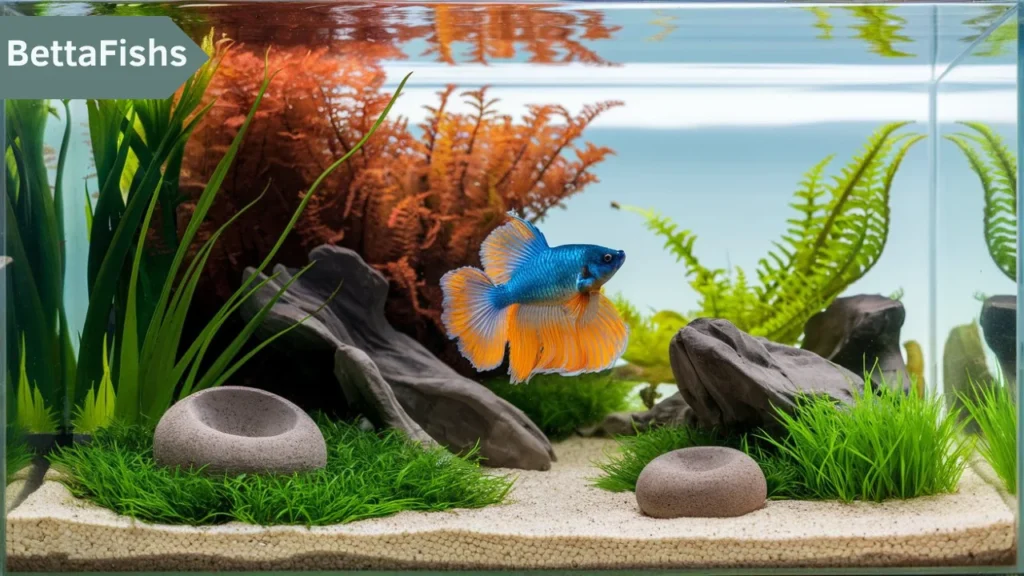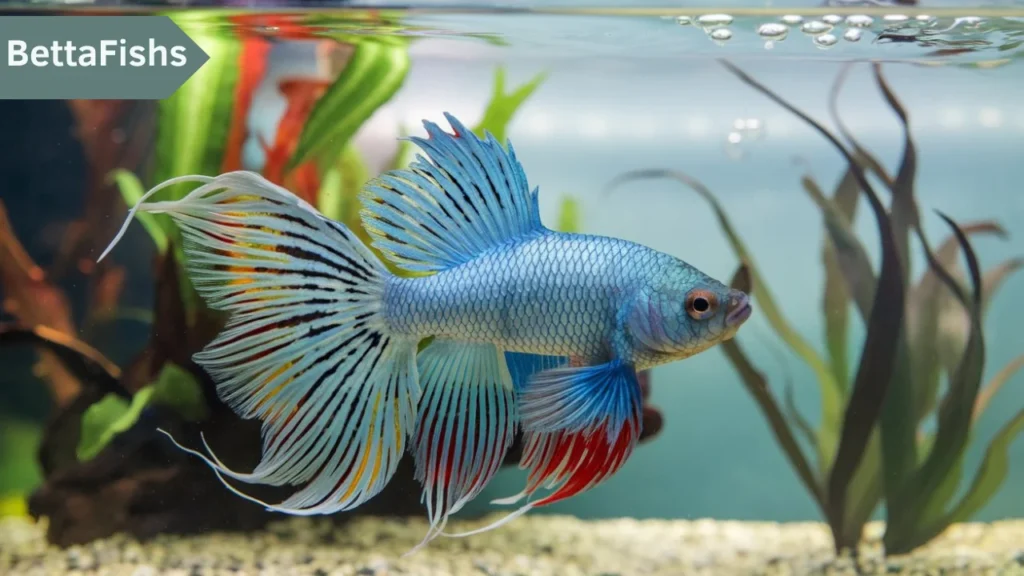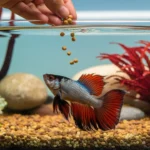If you are fascinated by unique and exotic fish, the Sea Bear Bluegill Betta Fish might just capture your interest. With its vibrant colors and intriguing behavior, this fish is becoming increasingly popular among aquarium enthusiasts. But what exactly makes the Sea Bear Bluegill Betta Fish so special? Their unique characteristics and needs are essential for anyone considering adding this fish to their collection. In this article, we cover ” Sea Bear Bluegill Betta fish ” in detail.
What is the Sea Bear Bluegill Betta Fish?
The Sea Bear Bluegill Betta Fish is a hybrid variety of the Betta species, known for its striking appearance and complex behavior. These fish are believed to have been selectively bred to enhance their distinct features, such as unique color patterns and a more robust build. Originating from the traditional Betta fish that are native to Southeast Asia, this particular hybrid has gained a reputation for being a showstopper in the aquarium world.
Origin and History
Like many Betta fish, the Sea Bear Bluegill Betta has its roots in Southeast Asia, particularly in the warm, shallow waters of Thailand and Cambodia. Over time, through selective breeding, enthusiasts have developed various Betta hybrids, each with unique traits. The Sea Bear Bluegill Betta stands out due to its distinct bluegill-like markings and robust body structure.
General Characteristics
This fish is known for its vibrant colors, ranging from deep blues to iridescent greens, combined with a variety of fin shapes and sizes. Unlike standard Betta fish, the Sea Bear Bluegill Betta tends to have a slightly more aggressive temperament, making it essential for owners to understand their behavior before introducing them into a community tank.
Physical Appearance
One of the most captivating aspects of the Sea Bear Bluegill Betta Fish is its appearance. The fish displays a remarkable blend of colors and unique fin structures, making it a true visual delight.
Color Variations
The Sea Bear Bluegill Betta Fish exhibits a range of colors, primarily deep blues, and greens with occasional hints of red or yellow. These colors can change slightly depending on the fish’s mood or health, adding to their appeal as dynamic and vibrant aquarium inhabitants.
Fin Shapes and Sizes
The fins of the Sea Bear Bluegill Betta Fish are particularly striking, often long and flowing with a slight curl at the tips. The size and shape of the fins can vary significantly between individuals, providing a unique look for each fish. Some may have broader, more fan-like fins, while others boast more streamlined, pointed shapes.
Distinctive Features
Apart from its stunning colors and fins, the Sea Bear Bluegill Betta Fish has a more muscular body compared to other Betta varieties. This robust build not only enhances its presence in the tank but also contributes to its more aggressive nature.
Natural Habitat
The natural habitat of the Sea Bear Bluegill Betta Fish is crucial for replicating these conditions in an aquarium setting.
Where They Are Found in the Wild
While the Sea Bear Bluegill Betta is a hybrid and not found in the wild, its ancestors thrive in shallow, warm waters such as rice paddies, ponds, and slow-moving streams in Southeast Asia. These environments are typically dense with vegetation and provide plenty of hiding spots, which help reduce stress for these fish.
Preferred Water Conditions
In the wild, Betta fish are accustomed to warm temperatures ranging from 75 to 80 degrees Fahrenheit. They thrive in slightly acidic to neutral pH levels and prefer soft water. Maintaining these conditions in captivity is vital for the health and well-being of the Sea Bear Bluegill Betta Fish.

Behavior and Temperament
The Sea Bear Bluegill Betta Fish is known for its bold and sometimes aggressive behavior, which can vary significantly between individuals.
Social Behavior in the Wild vs. Captivity
While these fish are solitary in the wild, preferring to live alone, captivity can sometimes alter their behavior. In an aquarium setting, they may display heightened aggression, especially towards other Betta fish or similarly colored species.
Aggression Levels and Compatibility with Other Fish
Given their aggressive tendencies, the Sea Bear Bluegill Betta Fish is best kept alone or with species that are not perceived as a threat. They can cohabit with non-aggressive, smaller fish species that do not resemble them in shape or color.
Diet and Feeding Habits
Feeding the Sea Bear Bluegill Betta Fish a balanced diet is crucial for their health and longevity.
What Do Sea Bear Bluegill Betta Fish Eat?
In the wild, Betta fish are omnivorous, consuming a diet of insects, larvae, and plant material. In captivity, they should be fed a mix of high-quality Betta pellets, live or frozen food like brine shrimp and bloodworms, and occasional plant-based foods to mimic their natural diet.
Feeding Guidelines for Aquarium Owners
To keep your Sea Bear Bluegill Betta Fish healthy, feed them small amounts twice a day. Avoid overfeeding, as this can lead to water quality issues and health problems such as bloating or constipation.
Aquarium Requirements
Creating a suitable habitat is essential for the well-being of your Sea Bear Bluegill Betta Fish.
Ideal Tank Size and Setup
A minimum of 5 gallons is recommended for a single Sea Bear Bluegill Betta Fish. The tank should have plenty of space for swimming and be equipped with a lid to prevent the fish from jumping out.
Water Parameters and Filtration Needs
Maintaining stable water conditions is crucial. Use a heater to keep the water temperature between 75-80°F, and ensure the pH is between 6.5 and 7.5. A gentle filter is also recommended to keep the water clean without creating strong currents.
Plant and Decoration Suggestions
Adding live plants like Java fern or Anubias can provide hiding spots and reduce stress. Decorations should be smooth and free of sharp edges to prevent injury to the Betta’s delicate fins.
Breeding Sea Bear Bluegill Betta Fish
Although difficult, breeding Betta fish may be a rewarding hobby.
Breeding Behavior and Rituals
During breeding, males will build a bubble nest at the water’s surface to house the eggs. Courtship involves the male displaying his fins and colors to attract the female.
How to Successfully Breed Them in Captivity
To breed Sea Bear Bluegill Betta Fish, it’s crucial to condition both the male and female with a high-protein diet before introducing them. Ensure the breeding tank is set up with plenty of hiding spots and has a calm environment to encourage successful mating.
Common Health Issues
Like all fish, the Sea Bear Bluegill Betta is susceptible to certain health problems.
Recognizing Signs of Illness
Watch for signs like discoloration, clamped fins, lethargy, or erratic swimming, which can indicate stress or disease.
Prevention and Treatment Strategies
Maintaining clean water, a balanced diet, and a stress-free environment are key to preventing illnesses. If health issues arise, prompt treatment with appropriate medications can often save the fish.
Tips for New Betta Fish Owners
If you’re new to keeping Betta fish, here are some tips to get started.
Basic Care Instructions
Keep the tank clean, provide a balanced diet, and maintain stable water conditions. Also, ensure your Betta has plenty of space to swim and hide.
Common Mistakes to Avoid
Avoid overfeeding, keeping them in too small a tank, or placing them with aggressive or similar-looking fish.
Compatibility with Other Fish Species
Choosing the right tank mates is crucial for the well-being of your Sea Bear Bluegill Betta Fish.
Best Tank Mates
Consider small, non-aggressive species like Corydoras catfish or small tetras, which can coexist peacefully with your Betta.
Species to Avoid
Avoid larger, aggressive fish or species with long fins, like guppies, which may provoke the Betta’s aggression.

Aquascaping for Sea Bear Bluegill Betta Fish
Creating an aesthetically pleasing and functional tank setup enhances the fish’s environment.
Designing a Suitable Environment
Incorporate a mix of open swimming areas and dense plant clusters to mimic their natural habitat.
Hiding Places and Open Swimming Areas Are Important
Providing both hiding spots and open areas helps reduce stress and allows the fish to exhibit natural behaviors.
Interesting Facts About Sea Bear Bluegill Betta Fish
These fascinating creatures have more to offer than just their looks.
Unique Behaviors and Traits
The Sea Bear Bluegill Betta Fish can recognize their owners and may even learn simple tricks, showcasing their intelligence.
Lesser-Known Facts
Did you know that Betta fish can breathe air? Thanks to their labyrinth organ, they can survive in oxygen-poor environments where other fish cannot.
Conclusion
The Sea Bear Bluegill Betta Fish is a captivating addition to any aquarium, offering a mix of vibrant colors, unique behaviors, and a hint of challenge for fish keepers. By understanding their needs and characteristics, you can provide a healthy and happy environment for these beautiful creatures.
FAQs
How long do Sea Bear Bluegill Betta Fish live?
They typically live for 3 to 5 years with proper care.
Are Sea Bear Bluegill Betta Fish hard to care for?
They are relatively easy to care for if you provide a suitable environment and diet.
What do I feed my Sea Bear Bluegill Betta Fish?
A balanced diet of Betta pellets, live or frozen food, and occasional plant-based foods is ideal.
Can Sea Bear Bluegill Betta Fish live with other Betta species?
It’s not recommended due to their aggressive nature, which can lead to conflicts.
What is the best tank size for a Sea Bear Bluegill Betta Fish?
A minimum of 5 gallons is recommended to provide ample space for swimming and exploration.




